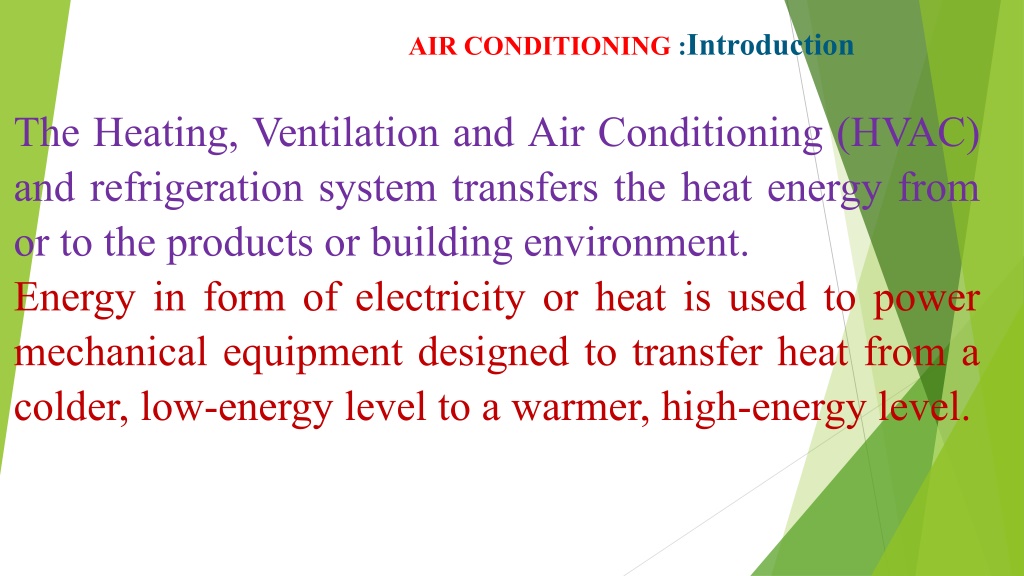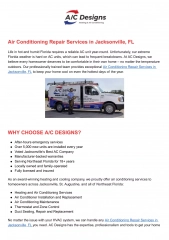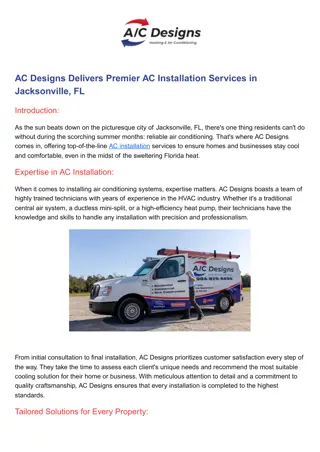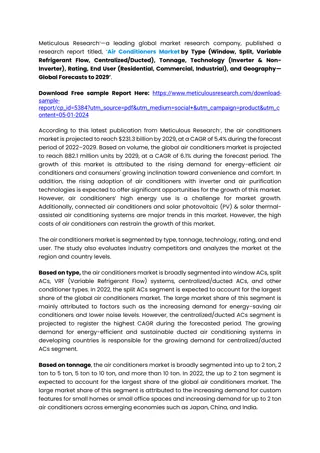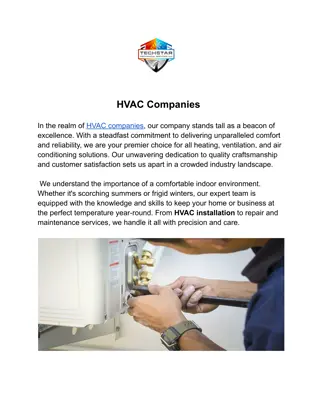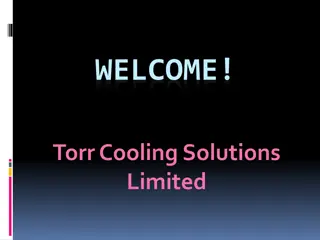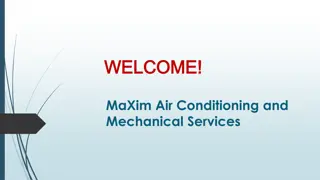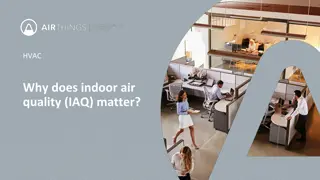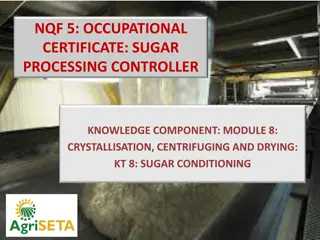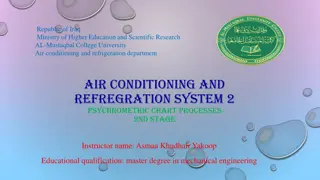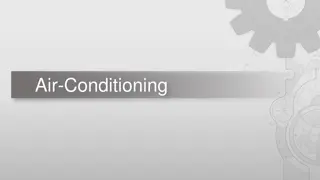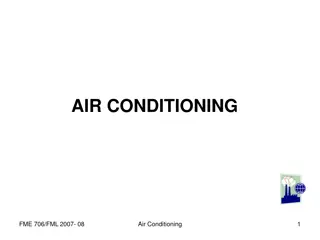Understanding the Basics of Air Conditioning and HVAC Systems
Introduction to the Heating, Ventilation, and Air Conditioning (HVAC) system along with the key components and functions involved in maintaining indoor comfort levels such as temperature, humidity, air quality, and air movement. Explains the importance of controlling the atmospheric environment for human comfort and industrial processes, as well as the physical properties of air that influence air conditioning systems.
Uploaded on Sep 21, 2024 | 0 Views
Download Presentation

Please find below an Image/Link to download the presentation.
The content on the website is provided AS IS for your information and personal use only. It may not be sold, licensed, or shared on other websites without obtaining consent from the author. Download presentation by click this link. If you encounter any issues during the download, it is possible that the publisher has removed the file from their server.
E N D
Presentation Transcript
AIR CONDITIONING :Introduction The Heating, Ventilation and Air Conditioning (HVAC) and refrigeration system transfers the heat energy from or to the products or building environment. Energy in form of electricity or heat is used to power mechanical equipment designed to transfer heat from a colder, low-energy level to a warmer, high-energy level.
COMFORT REQUIREMENTS Temperature Humidity Air movement Fresh air Clean air Noise levels Lighting Furniture and work surfaces 2
Air conditioning Air conditioning implies the automatic control of an atmospheric environment either for the comfort of human beings or for the enhancement of the performance of some industrial or scientific process. 3
Air conditioning An air conditioning system is composed of components and equipment arranged in sequence to condition the air, to transport conditioned air to the conditioned space, and to control the indoor environmental parameters within the previous specified limits. 4
For a person to feel comfortable it appears that the following conditions is desirable. The air temperature must be higher than the mean radiant temperature of the surrounding in the summer and lower in winter. The average air velocity in the occupied zone should not exceed 0.15m/s. Relative Humidity should desirably lie between 45% and 60%, and never to exceed 70%. 5
PHYSICAL PROPERTIES OF AIR PHYSICAL PROPERTIES OF AIR Dry bulb temperature Temperature of air indicated by an ordinary thermometer. Wet bulb temperature Temperature indicated by a Psychrometer when the bulb of one thermometer is covered with a water-saturated wick over which the air is caused to flow at approximately 4.5m/s to reach an equilibrium temperature of water evaporating into the air. When the heat of vaporization is supplied by the sensibleheat of the air. 6
PHYSICAL PROPERTIES OF AIR Temperature at which water vapor has reached saturation point (100% relative humidity) Ambient temperature Temperature of the medium surrounding the space, and in systems having air-cooled condenser it refers to the temperature at which air enters the condenser. 7
PHYSICAL PROPERTIES OF AIR Humidity Ratio Ratio of the mass of water to the total mass of a moist air sample. Relative humidity Ratio of the partial pressure or density of water vapor to the saturation pressure or density, respectively, at the same dry-bulb temperature, and barometric pressure of the ambient air. 8
PHYSICAL PROPERTIES OF AIR Dew point temperature Temperature at which water vapor has reached saturation point (100% relative humidity) Ambient temperature Temperature of the medium surrounding the space, and in systems having air-cooled condenser it refers to the temperature at which air enters the condenser 9
PHYSICAL PROPERTIES OF AIR Apparatus dew-point Dew-point temperature of the air leaving the conditioning apparatus, used interchangeably with the average coil surface temperature to produce dew. Enthalpy Thermodynamic quantity equal to the sum of internal energy plus the product pressure-volume work done on the system. 1 0
For a person to feel comfortable it appears that the following conditions is desirable. The dew-point should not be less than 2 C. The temperature difference between the head and the feet should be in range from 1.5 C to 3 C as maximum. The floor temperature should not be more than 26 C when people are standing and probably not less than 17 C. The dew-point should not be less than 2 C. 11
Continue The temperature difference between the head and the feet should be in range from 1.5 C to 3 C as maximum. The floor temperature should not be more than 26 C when people are standing and probably not less than 17 C. The carbon dioxide content should not exceed 0.1 per cent 12
Comfort Zone 13
Heat Transfer Loops In Refrigeration System Refrigeration deals with the transfer of heat from a low temperature level at the heat source to a high temperature level at the heat sink by using a low boiling refrigerant. There are several heat transfer loops in refrigeration system as described below: Heat Transfer Loops In Refrigeration System 14
Heat Transfer Loops In Refrigeration System In the Figure, thermal energy moves from left to right as it is extracted from the space and expelled into the outdoors through five loops of heat transfer: Indoor air loop. In the leftmost loop, indoor air is driven by the supply air fan through a cool-ing coil, where it transfers its heat to chilled water. The cool air then cools the building space. Chilled water loop. Driven by the chilled water pump, water returns from the cooling coil to the chiller s evaporator to be re-cooled. Refrigerant loop. Using a phase-change refrigerant, the chiller s compressor pumps heat from the chilled water to the condenser water. Condenser water loop. Water absorbs heat from the chiller s condenser, and the con-denser water pump sends it to the cooling tower. Cooling tower loop. The cooling tower s fan drives air across an open flow of the hot condenser water, transferring the heat to the outdoors. 15
Air-Conditioning Systems Air-Conditioning Systems Depending on applications, there are several options / combinations, which are available for use as given below: Air Conditioning (for comfort / machine) Split air conditioners Fan coil units in a larger system Air handling units in a larger system 16
Air conditioning applications Air conditioning engineers broadly divide air conditioning applications into comfort and process. Comfort applications aim to provide a building indoor environment relatively constant in a range preferred by humans despite changes in external weather conditions or in internal heat loads that remains 17
Comfort applications Comfort applications for various building types are quite different and may be categorized as Low-Rise Residentialbuildings, including single family houses, duplexes, and small apartment buildings High-Rise Residentialbuildings, such as tall dormitories and apartment blocks Commercial buildings, which are built for commerce, including offices, malls, shopping centers, restaurants, etc. Institutional buildings, which includes hospitals, governmental, academic, and so on. Industrial spaces where thermal comfort of workers is desired. 18
Air conditioning applications (Continue..) Process applications aim to provide a suitable environment for a process being carried out, regardless of internal heat and humidity loads and conditions. Although often in the comfort range, it is the needs of the process that determine conditions, not human preference. Process applications include these: external weather 19
Process applications (Continue) Aircraft air conditioning. Although nominally aimed at providing comfort for passengers and cooling of equipment, aircraft air conditioning presents a special challenge because of the changing density altitude associated with changes in altitude, humidity and temperature of the outside air In both comfort and process applications the objective may be to not only control temperature, but also humidity, air quality and air movement from space to space 22
HEALTH IMPLICATIONS A poorly maintained air-conditioning system can occasionally promote the growth and spread of microorganisms, such as Legionella pneumophila, the infectious agent responsible for Legionnaires' disease, or thermophilic actinomycetes,but as long as the air conditioner is kept clean these health hazards can be avoided. 23
AUTOMOBILE AIR CONDITIONERS Air conditioner systems are designed to allow the driver and or passengers to feel more comfortable during uncomfortably warm humid or hot trips in a vehicle. Cars in hot climates often are fitted with air conditioning. 24
